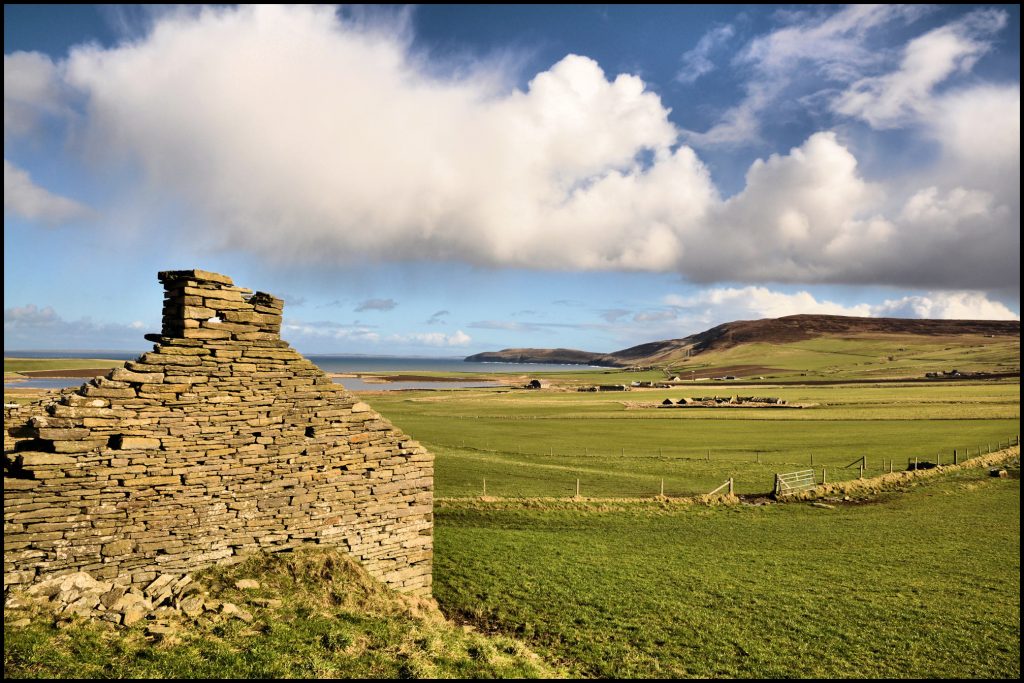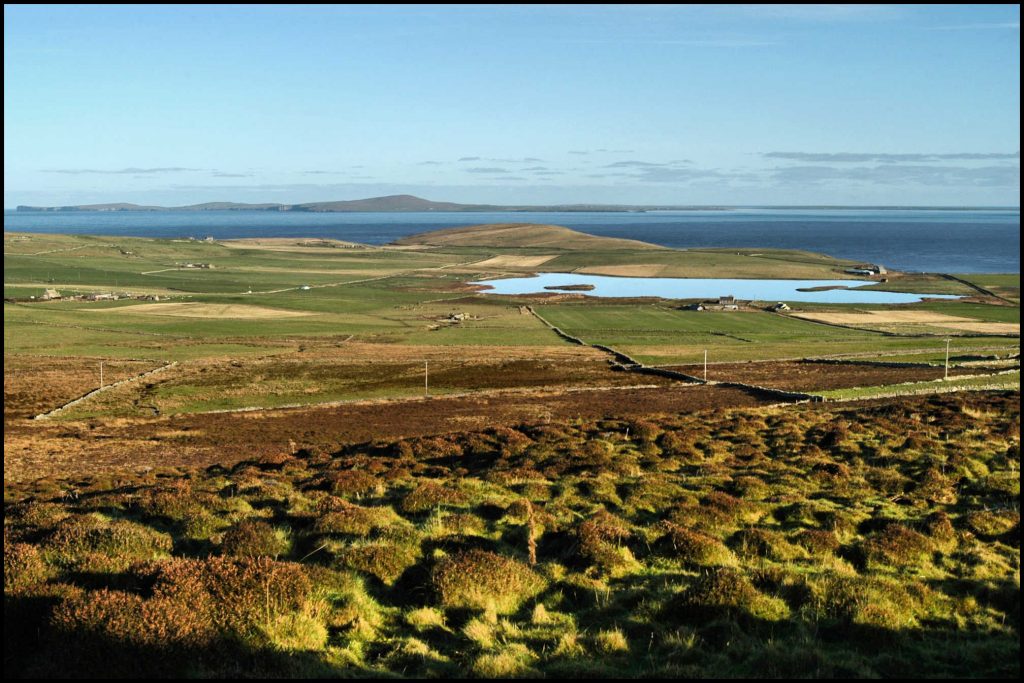Breckan and Hammer
Breckan was a farm in Wasbister, on the slope west of the loch, below Innister. Early tenants included Henry Corsie in 1736; Edward and Hugh Corsie in 1737; Marjory Moar in 1786; and James Louttit between 1792 and 1798.
In 1841 the surrounding land was farmed by 55-year-old William Louttit. He married Christian Craigie of Egilsay in 1807 and they had two children; Isabella, born in 1811, and Jane, born in 1816. William’s parents were James Louttit and Ann Mainland and Christy’s were Andrew Craigie and Isabel Hourston. Isabella Louttit married James Alexander in 1844, and it was he who took over 29-acre farm on the death of William Louttit in 1861.
Joint tenant of Breckan in 1841 was 60-year-old farmer James Alexander, originally from Cubbidy. In 1810 he married Barbara Marwick. She was the daughter of Magnus Marwick and Christy Craigie, and between 1811 and 1827 they had eight children, most of them being born when they lived at Cutclaws, an old house on the Westside. William, the youngest child, was lost over the cliffs there.
In 1861 Breckan was occupied by the second oldest of James and Barbara’s children. He too was christened James, having been born on February 24th 1815. In 1844 he married Isabella Louttit, the daughter of William Louttit and Christian Craigie, who was born in 1811. They had three children; William, born in 1846; James, in 1848; and Ann, born in 1850. Isabella’s father lived with them at Breckan, but he died in 1861 at the age of 80.
Above is a view of Wasbister from the Nuggle, with Innister just above and left of the stones, and Breckan, nearest buildings to the right.
In the latter years of the 19th century Breckan was farmed by Samuel Craigie. He was the son of Hugh Craigie and Jane Seatter of nearby Hammer, and was born on March 4th 1851. In 1876 he married Ann Craigie, daughter of William Craigie and Martha Mainland of Laro, and she was born on January 15th 1857. They moved to Breckan when the farm of Hammer became incorporated with Innister. Between 1876 and 1900 they had twelve children. Hugh, the fourth eldest born on March 7th 1884, fell to his death over the Quandale cliffs. The family was still at Breckan in 1891, but later they moved over to the Bu on the neighbouring island of Wyre.
The nearby farm of Hammer [of which no evidence now exists], spelt Hammyir in the 1503 Early Rental, and its neighbouring farm of Gorn later became incorporated with the larger farm, Innister.
The 1503 Rental states that: “Wasbustar wes evir to the Kingis scattis ane uris terre, and thairof the bischop takis the haill scattis of IIIId. terre ½ callit hammyir…..” That is – Wasbister was a whole urisland (18d. land) which paid scat to the King (or Earl), but in some unexplained way 4½d. lands had become bishopric land. That portion apparently went with a house known as Hammyir, a name we can still recognise today in Hammer.
Among the farms enumerated as paying landmail or rent to the earl were: Gore, 2d. land (no longer a farm, but still remembered as Gorn); Quoyostir (Quoyostray), 3d. land; Force (Furse), 1d. land; Grudwick, 1d. land (probably near Grithin); Calgir (Cogar), ½d. land; and Savirscale, 3d. land’
In the early 1800’s farmer David Craigie lived at Hammer. He was the son of William Craigie and was born in 1776. He married Marian (Mary Ann) Craigie in 1801, and between 1802 and 1819 they had eight children. Janet was born on February 4th 1802, Betty on October 8th 1804, James on March 1st 1807, Mary on April 3rd 1809, David on February 24th 1812, Isabel on February 12th 1815, William on August 20th 1817 and Hugh, who was born on July 7th 1819.
The word ‘flaa’ in the Orkney dialect means a strip of green grass standing out distinctly against a heathery background. In a Rousay lawsuit of 1825 Hugh Marwick, a Wasbister witness, depones that ‘he knows the road called the Strandygate……that David Cray of Hammer has two flaws of land which run across said road, making two riggs on each side of the road, or in other words the road divides the riggs in two, the ends touching the road on each side……John Inkster has two riggs in one place and a tae or half rig which cross the road, that is the road intersects these rigs and tae……all the rest of the land on each side of the road belongs to the petitioner consisting of eight flaws crossing the road and from these flaws extend riggs parallel to the road towards the shore lying on each side of it also belonging to petitioner……that the lands belonging to Lord Dundas……do not lie together but are intermixed and runrig with the flaws above deponed to belonging to the petitioner.’ [Kirkwall Sheriff Court Record Room.]
In 1851, David was 73 years of age, and Marian was in her 71st year. Their unmarried daughter Mary lived with them, and was described in the census as a 35-year-old servant. Her older brother James, now a 44-year-old fisherman, married 25-year-old Margaret Alexander in 1838. She was the daughter of James Alexander and Barbara Marwick of Breckan, and she and James also lived at Hammer.
The youngest of David and Marian’s children was Hugh, born in 1819. He married 26-year-old Jane Seatter of Saviskaill in 1849, and by 1851 they had two children; Mary Ann, born on August 2nd 1849 and Samuel, born on March 4th 1851, and they were living at Hammer as well.
By 1861, Hugh Craigie was head of the household at Hammer and farming its 26 acres. Jane had given birth to two more children; William on June 2nd 1853, and Jemima in 1856. Hugh’s mother had died by this time and his father, in his 84th year, lived with them, though he died in 1863. Hugh’s wife Jane died, and in 1871 he was farming 35 acres at Hammer, but he died himself in 1878 at the age of 59.
Then the new tenant of Hammer was Hugh Inkster. Hugh was the son of James and Margaret Inkster of Gorn, and he was born on February 25th 1845. He married Georgina Harcus, the daughter of John Harcus and Barbara Smith of Westray, who was born in 1848. Between 1867 and 1889 they had nine children, seven sons and two daughters.
Until 1878 Georgina and Hugh, who had been in ill health for many years, had lived with Hugh’s mother, but then Hugh, rather unwisely, took over the tenancy of Hammer, now a 15-acre croft with a house in poor condition. The stock had been provided by Hugh’s mother who gave up her own croft, Gorn, on the death of her husband and moved in with them, but, because of Hugh’s ill health, he had never been able to work the land very effectively. Hugh’s sister Margaret, who also lived with them, was an agricultural labourer, and she provided the only real income.
In 1881 the land was taken away from them, but they were allowed to continue living in the house. The laird, General Frederick William Traill-Burroughs, had built a steading on the neighbouring farm of Innister, but discovered it was too big and consequently decided to enlarge Innister at the expense of Hammer and two other crofts.
The plight of the Inksters became increasingly desperate. Hugh was unable to work, his mother was elderly and Georgina was encumbered by a family of young children; but for two years they survived on the money they received from the sale of their stock.
In 1883 that money was exhausted, the last being spent of sending Hugh to the infirmary in Edinburgh. Left destitute, Georgina applied for relief, only to discover that no-one was willing to make a decision while the laird was away on holiday in Germany. This was at the time of unrest in Rousay, due to the conflict between the crofters and the ‘Little General,’ as the unpopular laird was known.
The loss of the lands of Hammer caused feelings to run high and the whole district took sides. A row between the wives ended with Georgina throwing a bucket of dirty water over Ann Inkster, the wife of David Inkster who farmed the land at Innister, the incident leading to a Sheriff Court appearance.
Ploughs and scythes were broken at night, sheep belonging to one of the farmers disappeared and there were other violent incidents. John MacRae, Burroughs’s personal lawyer, ex-factor, and Procurator Fiscal, paid a visit to Wester to collect evidence for further charges against the crofters, but found the people sullen and uncooperative. Both the General and his factor had visited some of the troublemakers and, with tensions running high, the unfortunate school-master had chosen this moment to visit the destitute Hugh and Georgina with a demand for the payment of school fees. This resulted in the Sheriff having to deal with another case of assault!
By 1891, Hugh and Georgina had moved to Geo at Westness, and later they moved to Knapper. Hugh died in 1933 at Myres, aged 88, and Georgina died in 1934 at the age of 86.




